Two Poems By Sandra Simonds
by Mark Bibbins, Editor
Animal Kingdom
Make me a mutant cannon of DNA you can’t rein in,
a carrier pigeon cannon formed
of decomposed Morse code, hoar frost on the chromo-
some boats, the eyehole
bones of an abandoned women’s hello or the unborn.
Next, make me a lost mutt by
calling animal control. Put fur in one corner
and then follow her wag to the shelter. In your sonic
boom sonnet, Spaniel and Dachshund will bark
allele spirals until they breed dumb or smart, medium
or three-legged pigeon w/ woof. Make me
an earful of unusual birddogs, the left for dead
in fool’s gold, the side of the road way he
looks at you when he wants to go home. Hello?
Over Nothing
So what if a man hits a woman in the throat?
She’s not as beautiful as she once
was anyway. Her “power of refusal”
over prawns. Over steak? Over grilled
halibut? Over nothing. The dinner candles twist
more than Mulholland Dr., the restaurant’s
sommelier pours Los Angeles into crystal,
the couple leaves the valley in a car crosses a decade
but the problem is the same with different people
wearing the same clothes with different people’s
eyelashes fluttering the Great Plains
in between their hands. Like space
when the whole city breaks into the foaming,
red face of seawater on the edge of a sandy cliff.
Sandra Simonds is the author of Warsaw Bikini (Bloof Books, 2009) and Mother Was a Tragic Girl (Cleveland State University Poetry Center, 2012). She teaches English at Thomas University in Thomasville, Georgia.
Looking for more poetry? Boy, did you ever come to the right place! Check out The Poetry Section’s vast archive! There’s a whole lot of poems there for sure.
You may contact the editor at poems@theawl.com.
The Banks and New York City and the Media

I have had an NYPD-issued press pass twice. In New York City, the press is “credentialed” by the police department, independently of the City, at its discretion. The process is slow and you have to go downtown for quite a while. Both times I have been very careful to play their game. You have to bring published clips, among their required materials, that prove you need to deal with things like “robbery scenes, fires, homicides, train wrecks, bombings, plane crashes, where there are established police or fire lines at the scene.” Now I’m by no means a real reporter’s reporter, but I succeeded both times by bringing past stories that had, like, scenery of Hillary Clinton in a St. Patrick’s Day parade and what have you. On my most recent successful trip, I went with real reporters — and some of them got denied, and most definitely shouldn’t have been, while by working the system, I scored. The point that you’d need to be already doing that reporting to get credentialed (by the police!) to do that reporting is a good one. All this is a preamble to pointing out that yesterday we got used by the mayor’s office.
In the spirit of looking at what the media is, we talked about positions held by reporters who’ve been arrested around the country at Occupy Wall Street. I started doing this because I had a suspicion that some media trends were probably evident: were they all interns? Were they all unpaid? Freelancers? All men? Who were they?
The most notable things (to me) that we found were that a majority were non-staff reporters, they were from a wide cross-section of outfits (independent outlets, news wires, student papers) and that one staff reporter had already been laid off since his on-the-job arrest.
I tried to be pretty careful that this wasn’t to suggest that any of them weren’t “real reporters.” (One of those arrested in New York (who informed police he was a reporter), Jared Malsin, working for The Local East Village, was even deported from Israel last year for his reporting there.)
Then last night the mayor’s spokesman sent out a memo, citing our little exploration, and going further — cross-referencing the arrested reporters with holders of NYPD press passes.
He was doing this to assert that the NYPD wasn’t arresting reporters. He wrote: “We found that only five of the 26 arrested reporters actually have valid NYPD-issued press credentials.” Which, well, is basically an admission of arresting five NYPD-credentialed reporters? Or he was doing this to assert that they weren’t arresting real reporters. Well, we’re pretty much all real reporters now.
I don’t think the NYPD are monsters; I also don’t think Bloomberg’s office is evil. Nor are either of these organizations uniform in their thinking about Occupy Wall Street. I even think they’re in a tricky position — I don’t know how I’d deal with a large protest movement gathering in the City over the course of two months, especially one that’s trying to keep a permanent encampment in a park.
But I do think the City itself and even Bloomberg — despite some of his excellent qualities! — brought Occupy Wall Street on themselves. Throughout his unnecessarily extended tenure, he’s always been quick to give up income to benefit the banks. He’s done nothing truly effective about job creation, despite his small programs for helping startups and entrepreneurs, and the small creation of affordable housing. For example, everyone knew that Goldman Sachs’ “threat” to move to midtown was a bluff; they would never pay those rates, and that the state and the City went nuts on concessions for their new headquarters is still a crime. (Particularly when Goldman spit in their faces at the same time, moving more of their headcount to New Jersey anyway.)
The banks and New York City have always been intimately entwined throughout their history — probably, in the past, in far more unseemly ways than they are now. New York needs the finance industry; it is, obviously, a major “engine,” as they like to say, of the City’s micro-economy. But we believe that the finance industry and other related corporate enterprises have created a vast inequity, one that is nowhere more visible than in New York City itself. Here is where they have tortured capitalism into a sick thing that is actively bad for humanity. It’s only right that Occupy Wall Street has the name and focus that it does. How the rank and file of both the City and the NYPD deal with our mass nonviolent protests is on them, not us, and certainly not on the people reporting the events of the day.
Photo from New York’s Occupy Wall Street protests by Jon Tayler, who is both a Columbia J-School student and a reporter.
Whiskey Useless
I’ve spent the better part of an hour trying to figure out what possible need there could be for non-alcoholic whiskey and the only thing I could come up with is a sad scenario involving an old man with severe liver damage and a deep mixture of melancholy and nostalgia that can only be soothed by something that at least reminds him of the days in which he could drink. Maybe he’s mourning a dead child or something. Anyway, that’s about the best I can do, which seems pretty implausible. Hopefully it’s just a prank. [Via]
So How's the Art World Doing?

Chaos followed, as guests fought over pieces cut by the bare-chested pallbearers. “I want the breast! Give me the vagina!” they screamed, hardly noticing that Tilda Swinton had arrived for photo ops, looking very much like David Bowie in his Thin White Duke phase. When it was all over, the cut-up cakes resembled mutilated bodies that made for a ghoulish sight.
A man I didn’t know accosted me. “Is it me or was this all about violence against women?” he asked. “It’s you,” I said. “Look at that cake!” he exclaimed. “It’s a horribly mutilated woman with knives in her chest. Doesn’t that bother you?” “It’s a cake,” I said. “It represents all the indignities women have suffered at the hands of men. It is women telling their own history.” Apparently, the point was lost on him. “It’s disgusting,” he replied. I asked his name, which he declined to give. “I’m in the social register!” he growled, brushing past me to let Deitch know that this violence against women would result in the withdrawal of funding from the museum.
Doll Sweary
What is this doll saying that is so offensive? The audio seems unclear. I have narrowed it down to either, “You fucking cocksucker piece of shit, I will shove my fist so far up your dirty asshole that when it comes out of your whore throat you’ll feel like you’ve been using a metal cuntrag enema as a douche,” or “crazy bitch,” but it’s still kind of hard to tell. Anyway, the only good part of the holidays is the annual “Children’s Toy Does Bad Thing” panic, and now that we’ve burned it off for 2011, all we’re left with is relentless gloom until New Year’s. Enjoy.
The Real Numbers Behind 'Newsweek'
You won’t want to miss this thorough WWD report on life inside Newsweek. It’s mostly what you’d expect from Tina Brown: the magazine is constantly torn up, resulting in exhaustion and money burn, and, while some enjoy the thrill — being around a Tina turnaround joint is a great kind of rollercoaster! — the anonymous employee quotes are brutal. (Sample: “You’re exposed relentlessly to the truth that we’re not putting out a good magazine.”)
In the long term, who knows what’ll happen? For one thing, we know that Tina Brown will spend huge amounts of money until the checkbook stops delivering it. The figure always bandied about is that now NewsBeast loses $30 million a year. (An inconceivable amount of money, if you consider their net income, which is not insubstantial.) But what does the business trending of Newsweek actually look like, in real numbers?
From WWD: “Newsweek’s ad page performance between April to September was down 18 percent.” And from mid-2009: “down over 23 percent in advertising pages in the first quarter of the year compared with the first quarter last year.” And: “Newsweek ended 2010 with ad pages down 19.8% to 896.” This week: “Over all this year, Newsweek’s ad pages are down 21 percent.”
This “year over year” metric is confusing: it sounds like it means something, but you know: what happened last year then? To the Pew Center report!
This is magazine circulation in millions. Right now, Newsweek — that’s the steep downward-pointing red line! — has a rate base of 1.5 million, continuing that line.
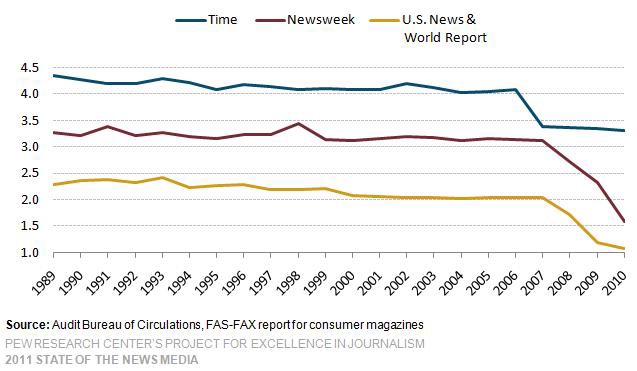
And ads? This is ad pages per year, in thousands:
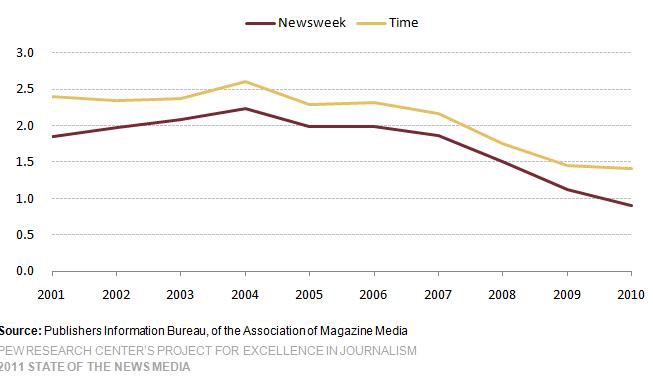
So you could say that for 2010, ads were down approximately 60% from 2004, or 50% from 2006. What does this actually mean in terms of real pages sold? The infamous resurrected Lady Di cover, the July 4th double issue, had all of 13.8 ad pages. (That’s a double issue!) A full-page, color, undiscounted ad page is quoted at $168,300. (And if they’re selling undiscounted full pages, I’ll cook a kitten and eat it. Pretty much no one does.) In June, at least, the magazine was doing an average of 24.5 ad pages per issue.
So there’s a bit of “turnaround” date from Newsweek in the WWD piece:
• “Subscription renewals are up 2.6 percent.” That’s not remotely exciting, given the circulation over the last five years.
• “It is up 6 percent on the newsstand, year-over-year.” That’s also not exciting; in mid-2009, Newsweek sold 85,000 newsstand copies per issue. In the first half of 2011, it was 46,561 copies.
Randomly, here’s my favorite bit from the NewsBeast rate card: the part where “survey says!” their readers literally don’t read anything else. I get that all of us who sell advertising want to say “we reach a unique audience” (while at the same time saying “our readers consume movies and books and gadgets constantly!”) but I’m not sure the metric of “our readers are otherwise not interested in reading” makes the case one wants to make.
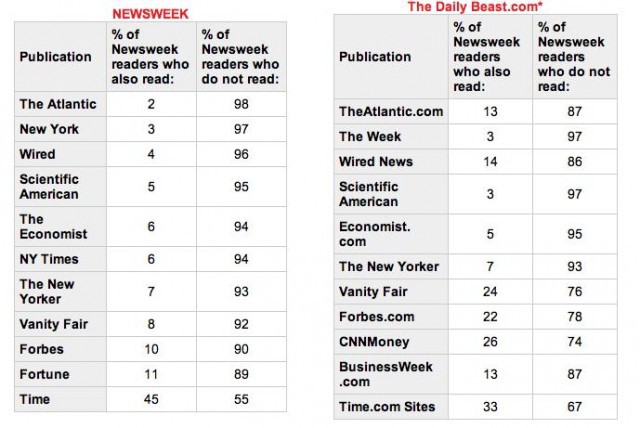
Football Pick Haikus For Week 11
Football Pick Haikus For Week 11
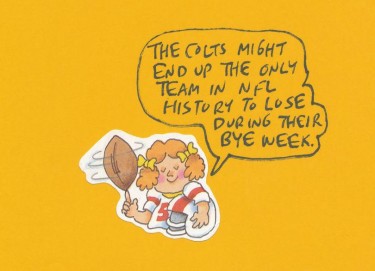
Thursday, November 17
NY Jets -6 At Denver
Thursday Night Football!
So just DVR “Whitney”
and never watch it. PICK: JETS
Sunday, November 20
At Atlanta -6 Tennessee
Atlanta coach blew
their last game in Overtime.
Falcons are grumpy. PICK: FALCONS
At Miami -2 Buffalo
“Don’t Stop Believing”
sang Journey and that also
covers “Bill-lieving.” PICK: BILLS

At Baltimore -7 Cincinnati
Ravens don’t show up
against teams that suck but the
Bengals do not suck. PICK: RAVENS
At Cleveland -1 Jacksonville
Play this game on an
Aircraft Carrier! Losing
Team walks the damned plank. PICK: JAGUARS
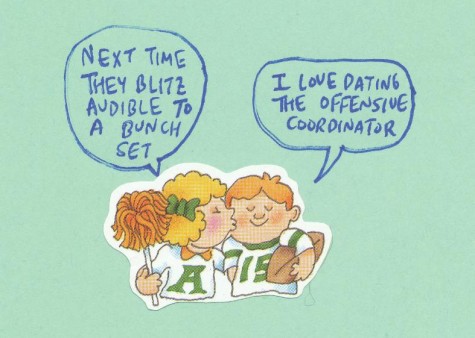
Oakland -1 At Minnesota
I’d ask Prince to play
halftime shows at Vikings games.
At least you’d see Prince. PICK: RAIDERS
At Detroit -7 Carolina
Lions gearing up
for their big Thanksgiving game.
Panther apéritif. PICK: LIONS

At Green Bay -14 Tampa Bay
The Bay of Pigs Game!
Packers might want to lose once
to take pressure off. PICK: BUCCANEERS
Dallas -7.5 At Washington
Some people want to fire
Redskins owner Dan Snyder.
Maybe he can QB. PICK: COWBOYS

At San Francisco -9.5 Arizona
It’s Bandwagon Time!
Coach Jim Harbaugh is Gandalf!
Frodo is his QB! PICK: 49ERS
At St. Louis -1.5 Seattle
Starbucks is closing
their public restrooms but you
should still take leaks there. PICK: SEAHAWKS

At Chicago -3.5 San Diego
The Chargers will start
winning now like they always
do in November. PICK: CHARGERS
At NY Giants -4.5 Philadelphia
Cris Collinsworth calls
Michael Vick “Mike Vick” which gives
me aneurysms. PICK: GIANTS
Monday, November 21
At New England -15 Kansas City
Matt Cassel is hurt
so New England won’t get to
thank him for leaving. PICK: CHIEFS
Last week’s Haiku Picks went 6–11. Grim! Season to date is 67–81–3.
Jim Behrle tweets at @behrle for your possible amusement.
When Is The Best Time To Tweet? (And Don't Say "Never")
“If you’re wondering when to tweet your most brilliant thoughts in order to maximize International exposure, it looks like 9am EST or thereabouts is a pretty good bet!” [Via]
A Survey Of Moon Maps Since the 17th Century
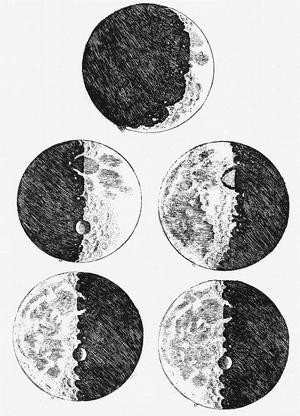
How do you map something 238,856 miles away? You can’t just send out a team of surveyors. At least, you couldn’t until relatively recently. Before then, lunar cartographers (technically, selenographers) could only rely on telescopes and their own artistic ability to draw a detailed portrait of the lunar face. They managed some pretty dazzling results.
One of the first widely seen images of the moon (aside from the IRL version), the drawing at left was included by Galileo in a book published in 1610. While he didn’t technically map the moon, these observations were among the first to take note that the moon was not a perfect smooth magic sky-ball but a rough, irregularly surfaced rock with valleys and mountains and other chartable features.
1645 — VAN LANGREN

The first formal attempt at mapping the moon — that is, one that didn’t just take note of curious craters and riveting ridges, but attempted to define all features on a grid — happened only a few decades later, in 1645. Dutch astronomer Michael van Langren attempted a detailed study of the moon’s visible surface during different phases, undertaken as a way of determining longitude here on Earth. He gave up on this (incredibly unsuccessful) quest early, but not before naming many of the observed features. Most of his names were in honor of Catholic saints and church figures of the day, but he did manage to find a crater to call “Langrenus,” after himself. Hilariously, it is one of only a handful of his names that stuck — you can see it on the eastern edge of the Mare Fecunditatis.
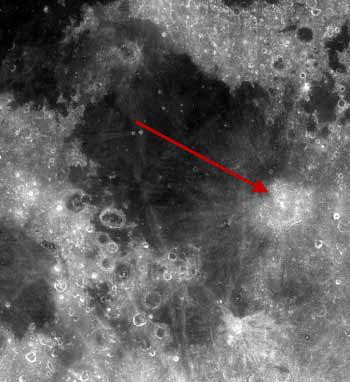
(Map courtesy of Universiteitsbibliotheek, Leiden, via; Langrenus close-up via Wikipedia.)
1647 — HEVELIUS
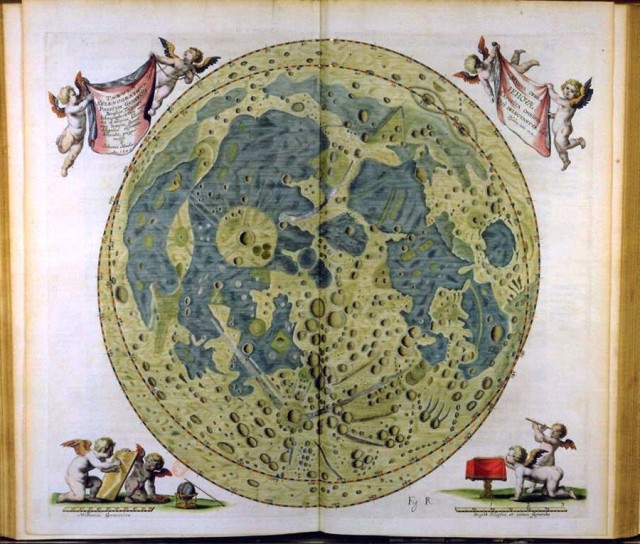
Two years later, Van Langren’s Polish rival, Johannes Hevelius, published a more complete description of the moon (literally, it bears the title Selenography, or a Description of the Moon) in the form of a lunar atlas. The two years of extra effort was worth it: Hevelius is remembered as the father of lunar topography. This year marks the 400th anniversary of his birth; Poland is currently enjoying a year of exhibitions and tributes to Johannes Hevelius as part of Rok Jana Heweliusz, which you can read more about here (if you happen to know Polish or enjoy the Google Translate interface). His maps, of course, had completely different toponyms. Unlike Van Langren, he named lunar features after what terrestrial features he thought them to resemble. Like Van Lengren, only a scant few of his survive, including moontain (not the official term) ranges named after the Pyrenees, the Apennines and the Alps. The Moon Alps even have their own Moon Alpine Valley. (Image courtesy of the Library of Congress, via.)
1651 — RICCIOLI
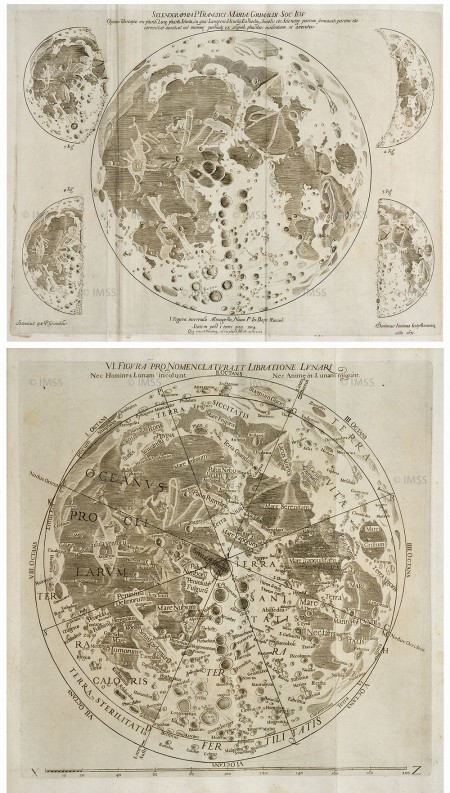
Enter priest Giovanni Riccioli. Not long after Van Lengren and Hevelius’ publications, Riccioli put out his own work. It didn’t really contain any actual new features, and it wasn’t really his work (it was drawn by Francesco Grimaldi), what makes it worth including here is his name scheme. All Latinized, the seas are named for various conditions generally attributed to the moon (tranquility, fertility, rain) and the lands for the opposites of those conditions (vivaciousness, sterility, heat). For individual craters, Riccioli divided the moon into a series of octants and grouped names by type regionally; for example, craters named after scholars are typically found all in the same general area. Most, but certainly not all, of his names are still in place today. Take a look at this picture, taken by Ranger 8 in 1965 about 4 minutes before it smashed into the surface — that’s the Sea of Tranquility, Mare Tranquillitatus, 314 years after it was christened by Riccoli.
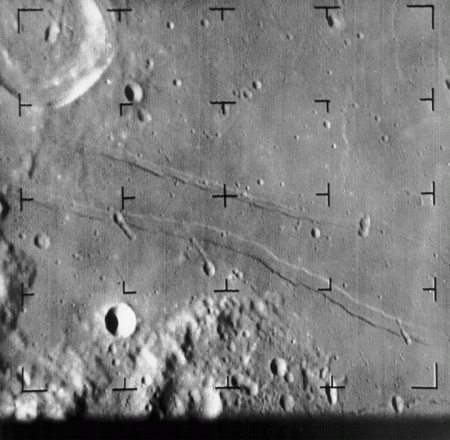
(Riccioli map courtesy of Museo Galileo; Ranger 8 image courtesy of NASA.)
1679 — CASSINI
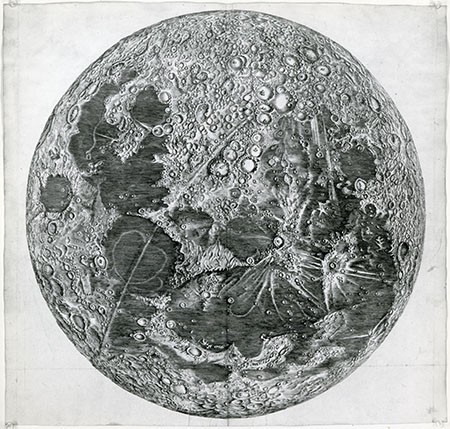
The 17th century was a great time to be alive if you were interested in staring at the moon — truth be told, moon maps were probably more accurate than earth maps at this point. Check out how much the art of seleography advanced between Galileo and Cassini, who published this map in 1679. Intrigued by an oddly shaped crater rim, he included a small drawing of a woman’s face in profile. Can you find Cassini’s ‘Moon Maiden’? Here’s a guide if you can’t. (Image via Museo Galileo.)
1748 — MAYER
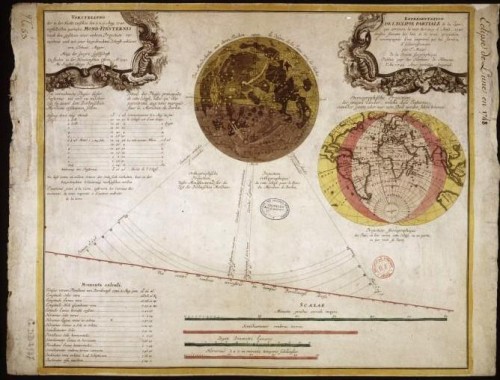
Van Lengren may have been the first to use a grid for lunar cartography, but Tobias Mayer was the first to give the moon proper latitude and longitude and take libration into account. See, though the far side of the moon would not be visible until the Soviets sent a satellite around in the 1960s, slightly more than half of the moon is observed nightly. The moon is not just a flat circular disc but a round three-dimensional object being hit by light from a rotating Ear….oh here, just look at this animation. I can’t explain it any better. Anyway: Mayer used his libration calculations in order to produce a series of incredibly accurate maps of the surface of the moon during a lunar eclipse on August 8, 1748. All of that aside, it is one gorgeous piece of cartographic art. (Image courtesy of the Bibliothèque nationale de France.)
Let’s leap forward here, for the next big developments in lunar cartography didn’t happen for 200 years. However, don’t take this to mean there was a two-century gap in moon mapping, nor that the advances made in those years are forgettable. However, going through each minute tip-toe forward only to end with “and then we landed on it! Good night!” — this is not the hill I want to bore you on. The next major advancements in lunar cartography came during the mid-20th-century space race between the USSR and USA.
1959 — THE SOVIETS
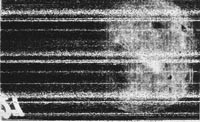
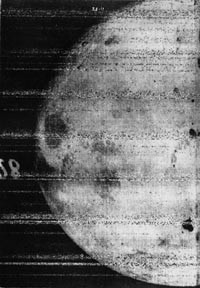
The Soviets were up there first, in 1959, sending up Luna 1, the first man-made object to leave the Earth’s atmosphere and never return. Unfortunately, it missed its target, and accidentally became the first man-made object to orbit the Sun. The Soviets, never ones to miss an opportunity, rechristened Luna-1 as “Mechta” and declared the 800-pound sphere a new planet. Luna-2 succeeded in hitting the moon, and (as seen here) Luna-3 sent back the first images of the far side of the moon, something previously only wondered about. Surprise! No moon yeti on that side, either. (Frames 27 and 28 of Luna-3’s film courtesy of Mental Landscape.)
1966 — THE AMERICANS
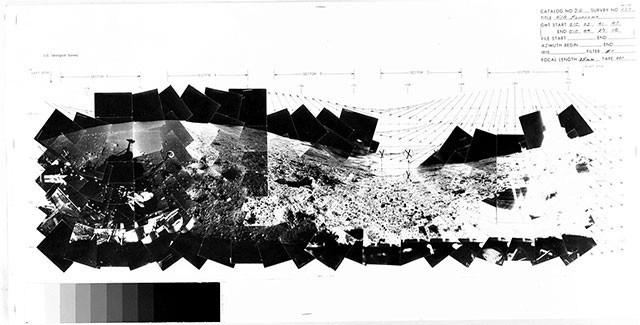
Between 1966 and ’68, the Americans, feeling as though merely looking at the moon wasn’t enough (well, they felt a lot of things, but you know, Cold War), launched seven individual spacecraft — the Jet Propulsion Laboratory’s Surveyor program — to the surface of the moon to transmit photographs and soil data, with the goal of testing the feasibility of a manned landing. As the program discovered, and a fact of which you are probably aware: totally okay to land on the moon! No signs of Moon Yeti anywhere, even after pretty close investigation! Surveyor 3, which scouted the Mare Cogitum, was close enough to the Apollo 12 landing site that astronauts were able to amble over to it and remove parts; the camera, which sent back over 6,000 images of the surrounding area, is now on display at the Smithsonian Air & Space museum. The above image is from the last of the program, Surveyor 7. Close up panoramas like these were used by NASA for, among other things, judging ground quality. None of the Apollo missions came even close to the crater-filled area where Surveyor 7 touched down — too risky. (Image courtesy of NASA; others here.)
2010 — NASA
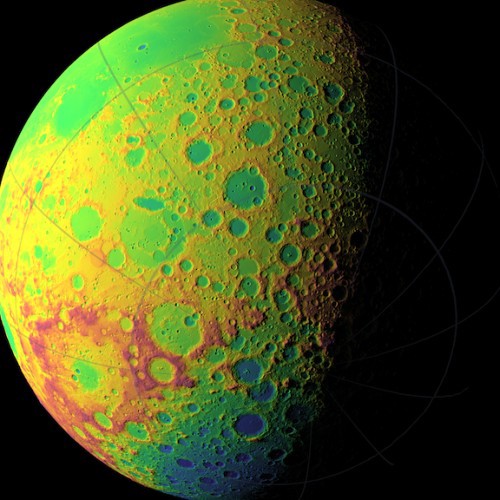
They’re still mapping the moon, by the way, even though there aren’t concrete plans to return. Clementine, launched in 1994, orbited the moon for two months and imaged every surface with a variety of instruments, including high resolution camera equipment and LIDAR. More recently, NASA sent up the Lunar Crater Obervation and and Sensing Satellite, or LCROSS, to smash into the moon’s south polar area and observe the dust plume resulting from the collision, a low cost way to check for polar ice, hydrocarbons, or other hydrated materials. And just last year, NASA embarked upon an unprecedented mission: a 100% complete map of the moon. Previous mapping efforts have only included the parts we can see, but the Lunar Reconnaissance Orbiter, launched at the same time as LCROSS, is already providing GPS-quality topographical data for regions of the moon that Johann Hevelius and his contemporaries only dreamed about. NASA has put out a video displaying some of the LRO’s truly stunning accomplishments so far. The mission was a success as well: the moon has water! It’s in the form of ice at the southern pole. (Image courtesy of NASA/GSFC/MIT/SVS.)
MOON CRASHES!
The moon’s seas aren’t filled with water, but you know what you will find in the seas? And also in craters, on ridges, and, basically, anywhere? Remnants of things that have crashed into the moon! Not all of these were as intentional as LCROSS, either. Among manmade debris like the Lunar Rover lie dozens of busted lunar projects. Like most, the American series of launches known as the Ranger project transmitted images back to Earth up to tenths of a second before impact. Here are a few of the last things they recorded.
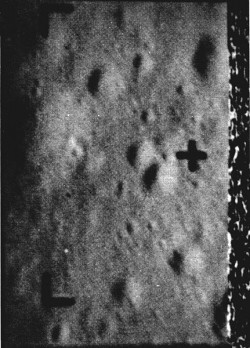
Ranger 7’s final image, July 31 1964. These images are incomplete — the static shows where the transmission ended. (Courtesy of NASA; via Wikimedia.)
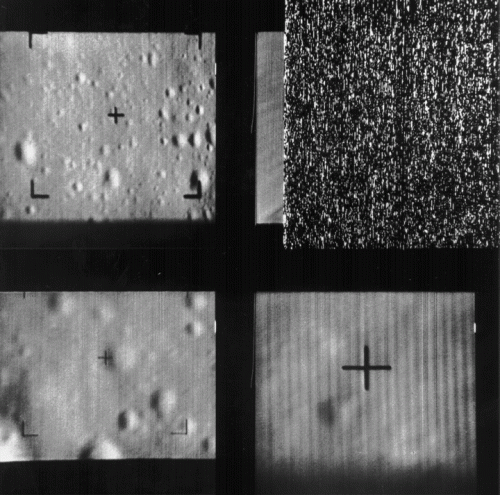
Ranger 8’s final image, a half-second before impact on February 20, 1965. (Courtesy of NASA.)
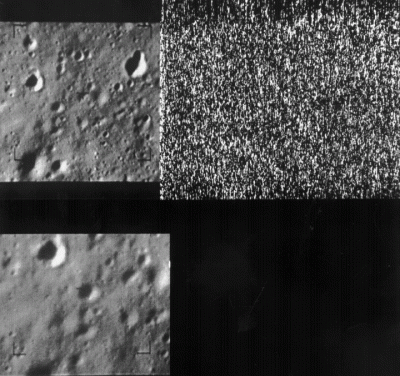
Ranger 9’s final image, tenths of a second before impact on March 24, 1965. (Courtesy of NASA.)
Victoria Johnson is a cartographer and this is her Tumblr. She wishes you a happy Geography Awareness Week!
Piggy Banks Turneth Away Wrath
“At around 6:25 p.m. on Monday evening, an armed robber wearing a ski mask and a long black coat forced his way into a private home in the town of Schwanewede after a babysitter answered the door, police reported Wednesday. Hearing the commotion, two small children in the house came downstairs — holding their piggy banks. They approached the gunman, who had been holding his weapon under the babysitter’s nose, and offered him their life savings. The man lowered his weapon and left without a word.”
